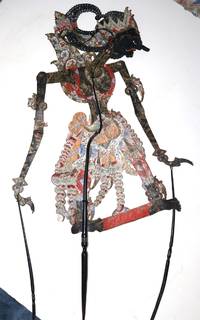Burma
Burma. Good. With many paintings directly into the manuscript of Buddhist deities and mortals (or so we assume), elephants, birds, etc. N.d. 19th Century, we believe. Closed, the manuscript is 34 by 13 cm. It has twenty panels on each side, for a total of 42 panels. The panels are sewn together with thread. Fourteen of the panels have substantial figurative artwork -- sometimes the full panel, and five panels have fortune-telling tables. The figurative illustrations and tables can be found integrated together, and when so, they were counted in both categories. Some of the tables have architectural shapes -- we didn't count these as figurative illustrations. Only four panels are purely textual, although the other panels can have a good amount of text along with artwork or tables. We don't pretend to understand the text. To the extend we did crude translation via Google Lens, we trust that a good amount is derived from Buddhist stories and maxims. We know that such things were spun into the complicated methodology of Buddhist divination and its presentation. For us, the pleasure of the manuscript derives from the exotic figures. These are winsome Folk Art. They are so not just because of their naive quality, but also the artist is basing his artwork on stock figures. However, he does endow the human and god-like figures with expression and movement. Whatever one thinks about the magic the manuscript is based upon and invoking, who can not revel in the magical quality of the artists' illustrations? In our manuscript also, the figures are painted with natural dye. Sometimes the color is spare, other times, quite rich, or one can see that it once was but it has lost its lustre over a century plus. While the writing is secondary to us, that doesn't mean we don't recognize the skill with which it was applied to the manuscript. Its neatness and regularity is impressive. We hesitate to call it calligraphy since we don't know how the writer or scribe and viewed it, nor how it was perceived by Burmese society at the time, or later. Whatever one's attitude towards the magic underlying the manuscript, few would argue about the magical quality of the artwork embellishing the manuscript. Cover, front and back, rough, with many raw spots, edge chips, etc. Within, soiled throughout, with stains, including ink stains, dampstains, smokey stains, etc. Some of the writing and artwork faded. However, we don't think there was any content wholly lost. Some closed tearing at the panel folds, and minor edge chipping to some panels. Some might find the wear and grime to be fitting for such a manuscript and a testament to its age.
(Inventory #: 20312)



























